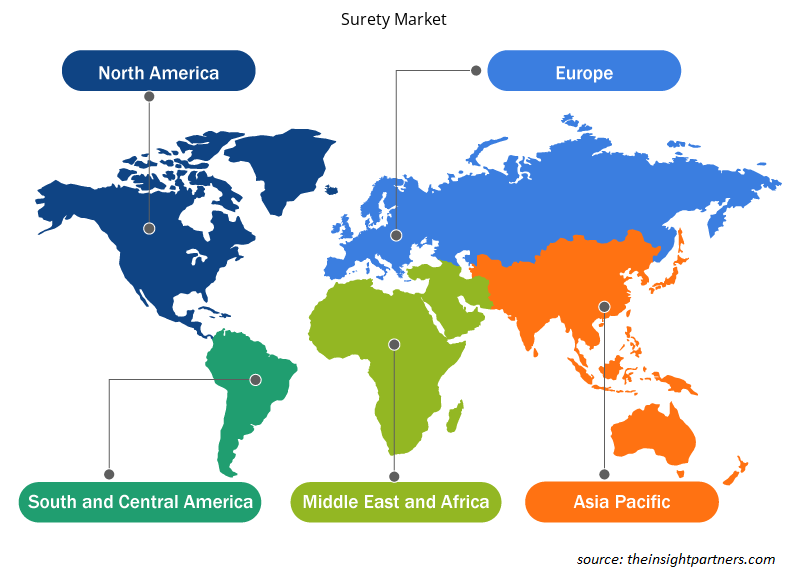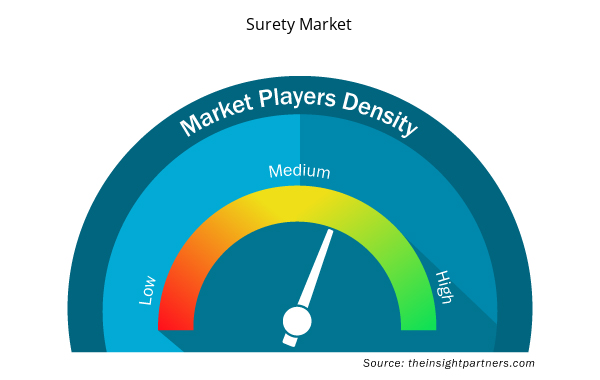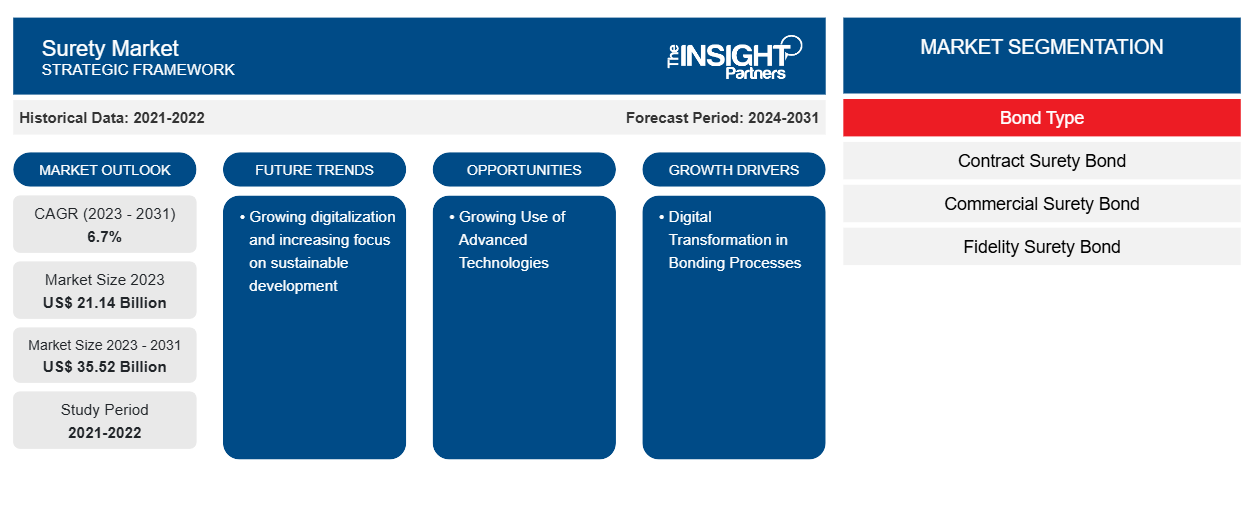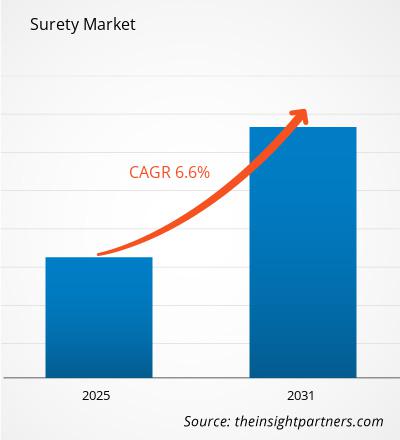Der Bürgschaftsmarkt soll von 21,14 Milliarden US-Dollar im Jahr 2023 auf 35,52 Milliarden US-Dollar im Jahr 2031 anwachsen. Der Markt soll zwischen 2023 und 2031 eine durchschnittliche jährliche Wachstumsrate (CAGR) von 6,7 % verzeichnen. Die zunehmende Digitalisierung und der zunehmende Fokus auf nachhaltige Entwicklung dürften weiterhin ein wichtiger Trend im Bürgschaftsmarkt bleiben.
Analyse des Bürgschaftsmarktes
Der Kautionsmarkt wächst rasant aufgrunddie wachsende Zahl von Bautätigkeiten und die digitale Transformation von Bonding-Prozessen. Der Markt wächst stetig, angetrieben durch die Verfügbarkeit maßgeschneiderter Bonds und die zunehmende Akzeptanz von Bürgschaften zur Verwaltung finanzieller Risiken. Darüber hinaus bieten der zunehmende Einsatz fortschrittlicher Technologien und der verstärkte Fokus auf Umwelt-, Sozial- und Governance-Faktoren (ESG) lukrative Möglichkeiten für Marktwachstum.
Übersicht zum Bürgschaftsmarkt
Eine Bürgschaft ist eine finanzielle Garantie oder Bürgschaft, eine Zusage, für die Schulden, Zahlungsausfälle oder Zahlungsunfähigkeit einer anderen Partei zu haften. Es handelt sich um eine Vereinbarung zwischen drei Parteien, bei der eine Partei (der Bürge) die Leistung oder Verpflichtungen einer anderen Partei (des Auftraggebers) gegenüber einer dritten Partei (dem Gläubiger) garantiert. Eine Bürgschaft dient als Zusicherung, dass eine Person oder Organisation die Verantwortung für die Erfüllung finanzieller Verpflichtungen übernimmt, wenn der Schuldner in Zahlungsverzug gerät und nicht zahlen kann. Die Partei, die die Schuld garantiert, wird als Bürge oder Garantiegeber bezeichnet. Bürgschaften können durch die Ausgabe von Bürgschaftsanleihen erlangt werden, bei denen es sich um Rechtsverträge handelt, die eine Partei zur Zahlung verpflichten, wenn die andere die Vereinbarung nicht einhält. Diese Anleihen werden häufig in der Bau-, Immobilien-, Finanz- und Transportbranche verwendet , um den Schuldner vor Zahlungsverzug des Auftraggebers zu schützen.
Passen Sie diesen Bericht Ihren Anforderungen an
Sie erhalten kostenlose Anpassungen an jedem Bericht, einschließlich Teilen dieses Berichts oder einer Analyse auf Länderebene, eines Excel-Datenpakets sowie tolle Angebote und Rabatte für Start-ups und Universitäten.
- Holen Sie sich die wichtigsten Markttrends aus diesem Bericht.Dieses KOSTENLOSE Beispiel umfasst eine Datenanalyse von Markttrends bis hin zu Schätzungen und Prognosen.
Regionale Einblicke in den Bürgschaftsmarkt
Die regionalen Trends und Faktoren, die den Bürgschaftsmarkt im Prognosezeitraum beeinflussen, wurden von den Analysten von Insight Partners ausführlich erläutert. In diesem Abschnitt werden auch Bürgschaftsmarktsegmente und die Geografie in Nordamerika, Europa, im asiatisch-pazifischen Raum, im Nahen Osten und Afrika sowie in Süd- und Mittelamerika erörtert.

- Erhalten Sie regionale Daten zum Bürgschaftsmarkt
Umfang des Bürgschaftsmarktberichts
| Berichtsattribut | Details |
|---|---|
| Marktgröße im Jahr 2023 | 21,14 Milliarden US-Dollar |
| Marktgröße bis 2031 | 35,52 Milliarden US-Dollar |
| Globale CAGR (2023 - 2031) | 6,7 % |
| Historische Daten | 2021-2022 |
| Prognosezeitraum | 2024–2031 |
| Abgedeckte Segmente | Nach Anleihetyp
|
| Abgedeckte Regionen und Länder | Nordamerika
|
| Marktführer und wichtige Unternehmensprofile |
|
Dichte der Akteure auf dem Kautionsmarkt: Die Auswirkungen auf die Geschäftsdynamik verstehen
Der Markt für Bürgschaften wächst rasant. Die Nachfrage der Endnutzer steigt aufgrund von Faktoren wie sich entwickelnden Verbraucherpräferenzen, technologischen Fortschritten und einem größeren Bewusstsein für die Vorteile des Produkts. Mit der steigenden Nachfrage erweitern Unternehmen ihr Angebot, entwickeln Innovationen, um die Bedürfnisse der Verbraucher zu erfüllen, und nutzen neue Trends, was das Marktwachstum weiter ankurbelt.
Die Marktteilnehmerdichte bezieht sich auf die Verteilung der Firmen oder Unternehmen, die in einem bestimmten Markt oder einer bestimmten Branche tätig sind. Sie gibt an, wie viele Wettbewerber (Marktteilnehmer) in einem bestimmten Marktraum im Verhältnis zu seiner Größe oder seinem gesamten Marktwert präsent sind.
Die wichtigsten auf dem Kautionsmarkt tätigen Unternehmen sind:
- Crum & Forster
- CNA Financial Corporation
- Amerikanische Finanzgruppe, Inc.
- Die Travelers Indemnity Company
- Liberty Mutual Versicherungsgesellschaft
- Das Hartford
Haftungsausschluss : Die oben aufgeführten Unternehmen sind nicht in einer bestimmten Reihenfolge aufgeführt.

- Überblick über die wichtigsten Akteure auf dem Bürgschaftsmarkt
Neuigkeiten und aktuelle Entwicklungen auf dem Kautionsmarkt
Der Bürgschaftsmarkt wird durch die Erhebung qualitativer und quantitativer Daten nach Primär- und Sekundärforschung bewertet, die wichtige Unternehmensveröffentlichungen, Verbandsdaten und Datenbanken umfasst. Im Folgenden finden Sie eine Liste der Entwicklungen auf dem Markt für Telekommunikationsabrechnung und Umsatzmanagement sowie Strategien:
- Core Specialty Insurance Holdings, Inc., ein Sach- und Unfallversicherer, wird American Surety in einer Aktien- und Bartransaktion übernehmen und damit neben Specialty Casualty, Property & Short-Tail und Fronted Programs ein Untersegment für Anleihen, Kredite und Garantien bilden. Dieser Übernahmevertrag soll im ersten Quartal 2024 abgeschlossen werden. (Quelle: Core Specialty Insurance Holdings, Inc., Pressemitteilung, 2023)
Bürgschaftsmarktbericht – Abdeckung und Ergebnisse
Der Bericht „Surety Market Size and Forecast (2023–2031)“ bietet eine detaillierte Analyse des Marktes, die die folgenden Bereiche abdeckt:
- Marktgröße und Prognose auf globaler, regionaler und Länderebene für alle wichtigen Marktsegmente, die im Rahmen des Projekts abgedeckt sind
- Marktdynamik wie Treiber, Beschränkungen und wichtige Chancen
- Wichtige Zukunftstrends
- Detaillierte PEST/Porters Five Forces- und SWOT-Analyse
- Globale und regionale Marktanalyse mit wichtigen Markttrends, wichtigen Akteuren, Vorschriften und aktuellen Marktentwicklungen
- Branchenlandschaft und Wettbewerbsanalyse, einschließlich Marktkonzentration, Heatmap-Analyse, prominenten Akteuren und aktuellen Entwicklungen
- Detaillierte Firmenprofile
- Historische Analyse (2 Jahre), Basisjahr, Prognose (7 Jahre) mit CAGR
- PEST- und SWOT-Analyse
- Marktgröße Wert/Volumen – Global, Regional, Land
- Branche und Wettbewerbsumfeld
- Excel-Datensatz



Report Coverage
Revenue forecast, Company Analysis, Industry landscape, Growth factors, and Trends

Segment Covered
This text is related
to segments covered.

Regional Scope
North America, Europe, Asia Pacific, Middle East & Africa, South & Central America

Country Scope
This text is related
to country scope.
Häufig gestellte Fragen
The global surety market was estimated to be US$ 21.14 billion in 2023 and is expected to grow at a CAGR of 6.7% during the forecast period 2023 - 2031.
The growing number of construction and infrastructure projects, rising concerns related to financial security among consumers, and increasing adoption of surety bonds among investors and project owners are the major factors that propel the global surety market.
The rising public-private partnerships (PPPs) in emerging economies and rising demand for green bonds among customers to play a significant role in the global surety market in the coming years.
The key players holding majority shares in the global surety market are Crum & Forster, CNA Financial Corporation, American Financial Group, Inc., The Travelers Indemnity Company, and Liberty Mutual Insurance Company.
The global surety market is expected to reach US$ 35.52 billion by 2031.
The incremental growth expected to be recorded for the global surety market during the forecast period is US$ 14.38 billion.
Trends and growth analysis reports related to Banking, Financial Services, and Insurance : READ MORE..
The Insight Partners performs research in 4 major stages: Data Collection & Secondary Research, Primary Research, Data Analysis and Data Triangulation & Final Review.
- Data Collection and Secondary Research:
As a market research and consulting firm operating from a decade, we have published and advised several client across the globe. First step for any study will start with an assessment of currently available data and insights from existing reports. Further, historical and current market information is collected from Investor Presentations, Annual Reports, SEC Filings, etc., and other information related to company’s performance and market positioning are gathered from Paid Databases (Factiva, Hoovers, and Reuters) and various other publications available in public domain.
Several associations trade associates, technical forums, institutes, societies and organization are accessed to gain technical as well as market related insights through their publications such as research papers, blogs and press releases related to the studies are referred to get cues about the market. Further, white papers, journals, magazines, and other news articles published in last 3 years are scrutinized and analyzed to understand the current market trends.
- Primary Research:
The primarily interview analysis comprise of data obtained from industry participants interview and answers to survey questions gathered by in-house primary team.
For primary research, interviews are conducted with industry experts/CEOs/Marketing Managers/VPs/Subject Matter Experts from both demand and supply side to get a 360-degree view of the market. The primary team conducts several interviews based on the complexity of the markets to understand the various market trends and dynamics which makes research more credible and precise.
A typical research interview fulfils the following functions:
- Provides first-hand information on the market size, market trends, growth trends, competitive landscape, and outlook
- Validates and strengthens in-house secondary research findings
- Develops the analysis team’s expertise and market understanding
Primary research involves email interactions and telephone interviews for each market, category, segment, and sub-segment across geographies. The participants who typically take part in such a process include, but are not limited to:
- Industry participants: VPs, business development managers, market intelligence managers and national sales managers
- Outside experts: Valuation experts, research analysts and key opinion leaders specializing in the electronics and semiconductor industry.
Below is the breakup of our primary respondents by company, designation, and region:

Once we receive the confirmation from primary research sources or primary respondents, we finalize the base year market estimation and forecast the data as per the macroeconomic and microeconomic factors assessed during data collection.
- Data Analysis:
Once data is validated through both secondary as well as primary respondents, we finalize the market estimations by hypothesis formulation and factor analysis at regional and country level.
- Macro-Economic Factor Analysis:
We analyse macroeconomic indicators such the gross domestic product (GDP), increase in the demand for goods and services across industries, technological advancement, regional economic growth, governmental policies, the influence of COVID-19, PEST analysis, and other aspects. This analysis aids in setting benchmarks for various nations/regions and approximating market splits. Additionally, the general trend of the aforementioned components aid in determining the market's development possibilities.
- Country Level Data:
Various factors that are especially aligned to the country are taken into account to determine the market size for a certain area and country, including the presence of vendors, such as headquarters and offices, the country's GDP, demand patterns, and industry growth. To comprehend the market dynamics for the nation, a number of growth variables, inhibitors, application areas, and current market trends are researched. The aforementioned elements aid in determining the country's overall market's growth potential.
- Company Profile:
The “Table of Contents” is formulated by listing and analyzing more than 25 - 30 companies operating in the market ecosystem across geographies. However, we profile only 10 companies as a standard practice in our syndicate reports. These 10 companies comprise leading, emerging, and regional players. Nonetheless, our analysis is not restricted to the 10 listed companies, we also analyze other companies present in the market to develop a holistic view and understand the prevailing trends. The “Company Profiles” section in the report covers key facts, business description, products & services, financial information, SWOT analysis, and key developments. The financial information presented is extracted from the annual reports and official documents of the publicly listed companies. Upon collecting the information for the sections of respective companies, we verify them via various primary sources and then compile the data in respective company profiles. The company level information helps us in deriving the base number as well as in forecasting the market size.
- Developing Base Number:
Aggregation of sales statistics (2020-2022) and macro-economic factor, and other secondary and primary research insights are utilized to arrive at base number and related market shares for 2022. The data gaps are identified in this step and relevant market data is analyzed, collected from paid primary interviews or databases. On finalizing the base year market size, forecasts are developed on the basis of macro-economic, industry and market growth factors and company level analysis.
- Data Triangulation and Final Review:
The market findings and base year market size calculations are validated from supply as well as demand side. Demand side validations are based on macro-economic factor analysis and benchmarks for respective regions and countries. In case of supply side validations, revenues of major companies are estimated (in case not available) based on industry benchmark, approximate number of employees, product portfolio, and primary interviews revenues are gathered. Further revenue from target product/service segment is assessed to avoid overshooting of market statistics. In case of heavy deviations between supply and demand side values, all thes steps are repeated to achieve synchronization.
We follow an iterative model, wherein we share our research findings with Subject Matter Experts (SME’s) and Key Opinion Leaders (KOLs) until consensus view of the market is not formulated – this model negates any drastic deviation in the opinions of experts. Only validated and universally acceptable research findings are quoted in our reports.
We have important check points that we use to validate our research findings – which we call – data triangulation, where we validate the information, we generate from secondary sources with primary interviews and then we re-validate with our internal data bases and Subject matter experts. This comprehensive model enables us to deliver high quality, reliable data in shortest possible time.


 Holen Sie sich ein kostenloses Muster für diesen Bericht
Holen Sie sich ein kostenloses Muster für diesen Bericht